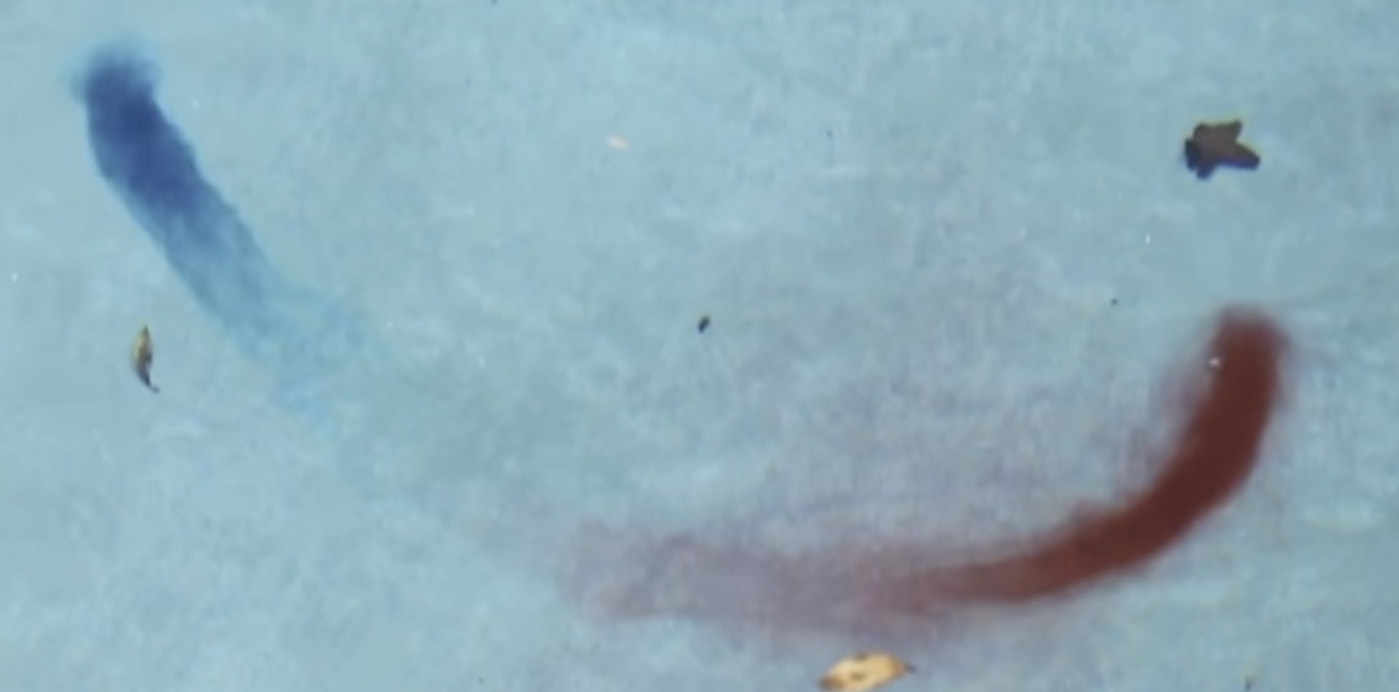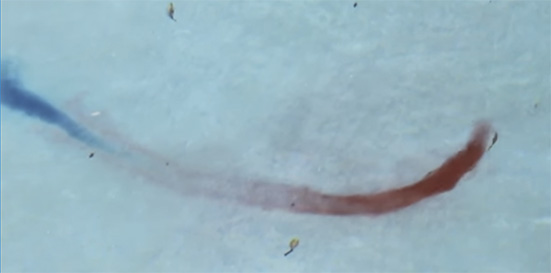How much don’t we know?
Giant pairs of whirlpools travel across the ocean for months in a bizarre pair.
These large paired whirlpools, hundreds of kilometers across, travel eastward at something like 10-20cm per second. This is one pair crossing from Tasmania to NewZealand. This was there in our satellite data but “invisible” til recently. As David Evans says “I wonder what else we are observing but not seeing?”

The ocean becomes connected at two distant points as the Modon-E whirlpool pair travels from Tasmania to NZ in 2010-2011
In the mini-pool version, these rolling whirlpools are connected in a U shape under water.
Wow. PhysicsGirl shows how to make these by pushing a plate through the water, and adding food coloring. Switch on your science nerd, show the kids! (send me your photos :- ))

The two vortexes spin in opposite directions but are connected as a pair underwater. This was created by PhysicsGirl using a plate in a pool and two different food colorings.
Twin giant ocean whirlpools travel for months winding their way across oceans
Peter Dockrill reports on an interview published in Popular Science
For the first time, scientists have recorded a bizarre phenomenon in fluid dynamics, which up until now had only ever been theoretically predicted, but never observed in the wild.
“Ocean eddies almost always head to the west, but by pairing up they can move to the east and travel ten times as fast as a normal eddy, so they carry water in unusual directions across the ocean,” explains oceanographer Chris Hughes from the University of Liverpool in the UK.
“What we found was a pair of eddies spinning in opposite directions and linked to each other so that they travel together all the way across the Tasman Sea, taking six months to do it.”
Since 1993, satellites have recorded nine of these pairs (called Modons). Eight of nine that have been found were around Australia. (Perhaps Australian-NZ oceanography is special, but I suspect other modons just haven’t been identified yet). From the paper:
h/t to David E
Watch Physics Girl do some extremely cool pool tricks.
I’ve seen 99% of the hands-on science tricks out there but this was totally new to me. Oogle away. The twin vortices leave pairs of shadows on the pool floor. They travel right across the pool, but vanish sometimes unpredictably, or are destroyed easily by any interference.
….
Notice the red ink whirlpool reaches over and envelops the blue one. The colors stay separate.

Mike Wehner:
You can think of an ocean eddy as something like an underwater tornado with two ends. The swirling water is sped along the twisting vortex, pushing it from one spot in the ocean to another. They’re a well documented natural phenomenon, and serve to regulate temperatures and transport nutrients over large distances, but fast-moving twin eddies put a new spin on what scientists thought they already knew.
Researchers were able to observe the odd ocean behavior using satellite data to measure the depth at which the eddies took shape as well as the speed of the water within them. The flowing water acts like a two-lane highway, moving in both directions simultaneously.
For any small sea creatures not capable of escaping the vortex, the ride can be a long one.
We’re not sure how they are formed. From the paper:
Never too old to get excited. :- )












Perhaps Royal Doulton makes Tectonic Plates………….
120
This obviously release masses of CO2 so we must spend $1B on investigating this phenomena. Sure to get 1k researchers at climate change rent seeking guv backed institutions to provide the “labour”.
No doubt they will need several hundred years to look into this carefully and hold worldwide conferences.
Then their may be “victims” of the vortex. A new UN pressure group must be formed to work out a compensation methodology. Then there is the “stakeholders” group…….
Lastly, there must be a connection between vortices and Donald Trump’s tweets. The FBI needs to set up an investigation, there may be a Russian connection.
171
Perfect 🙂
30
Gerbil Warming strikes again!
132
Bizarre truly freaky and also interesting just what we don’t know about our planet .
130
https://teara.govt.nz/en/taniwha
Taniwha / taa-nee-faa. Ancient Polynesian / Maori navigators knew these. Finally, white-lab-coat-science catches up.
141
I think Science Girl tells a much better story, demonstrates it better, and explains it better.
62
Oh Craig! You obviously have no idea at all about what you’ve said.
ROTFL
Had another attack of mental diarrhea? Obviously, Craig, you’re a walking, talking, encyclopaedic suppository carrying the complete knowledge of the waka hourua, and everything to do with sailing it, from the shipcraft, through the Navigation methods, how to find land from the wave shapes and swell behaviour, and especially all about the hazards they faced and coped with.
Well?
Are you going to enlighten us all?
We’re waiting on you … but not holding our breath …
And it’s Physics Girl, not Science Girl.
For that you get the Flower of the Week Award! (A Pansy 🙂 )
62
sophocles:
Craig has been drinking so he is a pickled dill.
10
Anethum graveolens (common or garden dill) doesn’t have as large nor as colourfully attractive a flower as the violaceae.
🙂
00
… although both do have humorous associations … 🙂
00
“so he is a pickled dill.”
So brain-washed, with high pressure hose, that his cranium is full on slimy green mush.
Think of pickled dill, put through a blender.
11
Was there not a vortex in the Caribean that swallowed ships? That id the place to look.
50
The Bermuda Triangle (close to the Caribbean) is noted as taking ships and airplanes.
10
So South Australians are not only proof that Tasmanians can swim, but that they can swim against the current.
Stand by for my theory that New Zealanders are just conformist Tasmanians. (Not you RW – special dispensations apply.)
70
Obviously it’s an attempt by Russians in collusion with the Trump Administration to disrupt commercial fishing in the Tasman Sea at the behest of the Big Fishstick Cartel. I have a dossier on this for sale now that I’ve retired from MI7 (we go MI6 one better). By the way, didn’t David Evans get it bassackwards? Shouldn’t he have said, “I wonder what else we are seeing and not observing?”
111
Hmm! Another go at the Cod War!
Tony.
(Apologies to Graeme, Tim and Bill)
140
Never seen before, therefore caused by CO2 and BAAAADDDDD!!!
Hamlet:
And therefore as a stranger give it welcome.
There are more things in heaven and earth, Horatio,
Than are dreamt of in your philosophy.
There are also more things not yet thought of nor discovered that are not in the climate models.
91
A quite familiar familiar phenomenon for those with rowing experience. The oars leave those vortex pairs for each pull. Vortex pairs in grand scale are really interesting.
150
True, but I had no idea that they could be connected in such a way.
I learn something new every day, though it is equally possible I forget something every day too…
170
Yea, seen them many times. I always thought they were vertical.
20
Really big oars required for those. Like monstrous!
Maybe Charon is snooping around the Tasman Sea, or does he punt his ferry boat?
20
Nobody can pay the gold coin passage these days. We’re all stranded on shore.
10
Tradition has it that he accepted a copper coin, like the Hellenic obolos, or later a danake, for the crossing. The tradition, even to quite recently, was to place the `ferryman’s fare’ as a coin in the mouth of the deceased.
See Charon’s Obol for a bit more detail.
10
Thinking about it, I wonder how much the shape of the object matters- the shape of an oar in the water is not the same as a nice round plate…
Now, where to find a swimming pool, and some oars…
Canoe Polo…!!
10
***
Ari Okkonen beat me to it, but I stir tea and don’t row! And every airplane does the same thing. Still very interesting to be shown how effective it is in the Ocean.
CWC
***
90
The video of Physics Girl’s demonstration was excellent.
In the field of instrumentation we use vorticies to measure flow. There are many excellent YouTube videos on the topic. A general explanation is here: https://karlgaff.wordpress.com/karman-vortex-streets/
My thoughts on this post are as follows:
Vorticies may be formed when a solid body is placed in a flow path (water or gas). You can see this when you look a a river and underwater logs form eddies.
Now ocean currents can be slow but the energy contained is vast. I understand that a current flows down the east coast of Australia and another along the south coast and the two meet on the eastern side of Tasmania.
These two ocean currents are near the top of the list for their length and power and the amount of water flowing in them.
I do not know if these two currents meeting would form a double whirlpool however there may be an additional influence.
The ocean current flowing along Australia’s south coast also flows around Tasmania. That is, there is flow along the south of Tasmania and the north through Bass Strait. The northern current is special because the water mass must travel between the mainland and Tasmania where the depth is about 50 metres.
The water depth of the Bight is as much as 4000 metres so when the sea bed changes from 4 kilometres to 50 metres the water must speed up creating a high flow intersecting the eastern seaboard south flowing current.
My thought is that this high flow intersecting current may form an effect like the Physics Girl’s plate causing the two ocean currents to form a double whirlpool.
It may also be that Tasmainia itself acts like a block body causing or assisting the whirlpool formations.
150
I’m out of my depth, but this captured my attention.
https://earth.nullschool.net/#current/ocean/surface/currents/overlay=sea_surface_temp_anomaly/orthographic=-200.24,-37.27,3000/loc=153.327,-41.431
30
Fascinating.
Assume we are looking at surface movement.
Cause?
Wind?
20
We can leave out wind, its clearly something something else.
00
No, it’s fluid turbulence, not atmospheric.
I read somewhere not all that long ago, and did not note the source, which I now regret, about massive long-lived eddies or whirlpools in the sea, well away from land. It said something about the ocean having its own internal analogs to atmospheric weather.
40
Maybe it has something to do with the magnetic field.
https://svs.gsfc.nasa.gov/4541
00
My bet is on a river mouth and an out-going tide.
10
Its more complex methinks.
‘A seafloor array of recorders spanning the Tasman Sea has measured the electric field signature of a major warm-core ring embedded in the East Australian Current. Theory for motional electromagnetic induction allows the electric measurements to be interpreted in terms of barotropic water velocity. Water transport and kinetic energy estimates thus obtained show a concentration of mesoscale activity near the Australian coast. The total circulation of the particular ring is estimated to be of the order of 100 Sv.’
Lilley et al 1986
11
I agree with KK … fascinating.
20
Thanks for the outline. Enormous power in the water movement. It would be interesting to know whether surface winds interact with the powerful currents.
KK
00
I wanted to run out to the pool and try this, but it’s currently frozen solid with an outside temperature of -14C. I did notice that the pool she used doesn’t appear to be operational. The circulation pump looked to be off and the water condition was poor. I’m assuming that the normal pool circulation would kill of the vortex pretty quickly. Something to play with when it gets a bit warmer.
70
What I saw in the pool demonstration would seem to be the same thing pilots call wing tip vortices. I’m left wondering if a similar joining up happens in the atmosphere behind a big jet and we can’t see it. I can’t even think of an experiment that would make it visible. You can’t just drop a little food coloring in the vortex behind that jet as it lifts off at roughly 150 knots when the vortex is strongest.
It’s an interesting world we live in.
As a guess — I know the vortex behind each wing tip spreads out behind the plane and I wonder if they meet, bump into each other at some point and rotating in opposite directions, can manage to join up and reinforce each other. I know the vortex pair behind a big jet flying at low speed can linger for a long time, sometimes as much as 5 minutes before it’s dissipated completely.
70
I often watch planes landing. In just the right conditions, the airflow over the top of the wing creates instant condensation at various points over the wing and at the wing tip.
The reason very little vortical activity is visible is design: you definitely do *not* want vortices forming when you are going for aerodynamic efficiency.
Have a look at this, it’s well cool:
https://en.wikipedia.org/wiki/K%C3%A1rm%C3%A1n_vortex_street
And this:
http://dl.btc.pl/kamami_wa/hk_24474_2.pdf
30
The vortices I’m talking about happen at the wingtip and are a result of air pressure being higher on the bottom of the wing than it is on the top. That’s why the wing generates lift. The wingtip is a place where nothing prevents air from moving from bottom to top and so it does. Instant vortex and they’re created whether they can be seen or not. Those little vertical fins you see on the newer planes are to prevent that airflow. However, they’re only partially effective and the vortex still happens. It’s just reduced in magnitude. Their net benefit is that you get more lift from the same wing and airspeed.
Those vortices are a real hazard to smaller aircraft and have caused more than one crash when a single engine pilot landed too close behind a big jet. If you get into it it will roll you uncontrollably.
Some of the shots in David Maddison’s link show exactly what I’m talking about. When flying into a cloud the vortex on each side can be seen to spread out and they appear to be doing roughly what the demo in the pool is showing.
30
I’ve often wondered if interrupting the flow in a manner similar to that used by humpback whales acts by creating a destructive waveform where the multiple vortexes peaks and troughs cancel each other out.
maybe someone could push a frilly edged plate through a pool and see. I suspect ruffles would work similarly to a wavey edge.
10
“you definitely do *not* want vortices forming “
Whatever you say, CT. 😉
http://www.boldmethod.com/images/pages/learn-to-fly/aerodynamics/wake-turbulence/wake-757-nocredit.jpg
http://deskarati.com/wp-content/uploads/2012/07/Wingtip-Vortices.jpg
https://media.gettyimages.com/photos/corporate-jet-with-vortices-picture-id71558101
https://i.ytimg.com/vi/dfY5ZQDzC5s/maxresdefault.jpg
https://i.pinimg.com/originals/e1/aa/04/e1aa0435027f68a812203db99035ff88.jpg
01
Every plane creates them..
and its from the wing tips, not over the top of the wings.
but as CT says in his wealth of knowledge….
“you definitely do *not* want them”
So funny ! 🙂
http://code7700.com/images/wingtip_vortices_infrared.jpg
12
Andy,
Actually he’s correct. You really don’t want the wingtip vortices because they represent a danger to following aircraft and they reduce the lift you could otherwise get from the same wing. And eliminating the vortices is what those little winglets are all about on the newer jets. They don’t completely eliminate the vortex but it’s reduced a lot and by doing that you gain quite a bit more lift from the same wing design and size. The reason is very simple, the winglet maintains a higher pressure differential between the bottom and top areas of the last few feet of the wing and that pressure differential is what lifts the plane. More pressure differential equals more lift.
Craig appears to mistake the condensation over the top of the wing for a vortex, which it isn’t but it is evidence that the pressure is lowered on top of the wing and that is exactly what the designer does want. No pressure reduction over the top surface would mean no lift and no flight.
Actually you don’t really want that “flutter” as one of his links describes it. But physics is what it is. And just think, if not for that phenomenon such beautiful and versatile instruments as the flute, clarinet and oboe would be impossible. Those instruments are specifically designed to crate that flutter at audible frequencies but the airplane designer would rather be without that little artifact if he could eliminate it. I flew a plane for a while with a NASA designed wing that apparently did reduce that flutter effect.
Any airplane will pull 2 g at a 60° bank angle in level flight. That’s the FAA regulation limit for intentional turns except in an emergency. If you could see the additional pressure differential under those conditions it might scare you witless. The airplane itself has to be able to withstand much more than that because turbulence can be completely unpredictable. If I remember plus 6 g and negative 4 g is the design requirement. However, I think the manufacturer only needs to demonstrate safety at some lower figure. Pushing the design limit is not very sensible while several thousand feet in the air.
Ain’t flight aerodynamics fun?
10
Wind turbines also have wingtip vorticies. The three twist around each other in a helix……not sure what happens after that.
00
That’s a lot of impressive maths, more impressive when you realise that the early engineers solved these structure and aircraft design problems without the aid of modern computers and design software.
00
It all came about because someone finally investigated the shape of bird wings and tried to duplicate that. They were successful and the glider was born.
Bernoulli’s principle was well known and a light bulb lit up and guess what? Two bicycle mechanics from Dayton Ohio decided to try for powered flight. They succeeded and the rest, as they say, is history. They had both flown gliders and were well familiar with how they worked and all they really did was scale up their machines from what they knew best, the gliders thay had flown in the past. But that was their ultimate downfall because it led them to a completely impractical design and it took Glen Curtiss to make flying practical.
The wrights were impressive anateur engineers and scientists, even designing a wind tunnel to test propeller designs. But I doubt that they ever knew anything about wingtip vortices.
The most math they would have needed was to compute weight and balance and compare that with the lift and control authority their first unpowered airplane could generate. Once they had those numbers mastered they had their Kitty Hawk flight in 1903 firmly in their hands.
00
Here are some aircraft vortices.
https://youtu.be/dfY5ZQDzC5s
00
That wing vortex on the lufthansa.com aircraft is pretty interesting. It was curled up like an umbilical cord. I’m also amazed just how persistent the landing vortexes are.
20
You can see the wingtip vortices doing what I theorized about at:
0:20
3:15
5:37
into the the video as the planes enter the clouds. They appear to join up just a few seconds behind the plane. Whether this is actually the same thing Jo is talking about or not is something for greater experts than I am.
There is a difference between the condensation seen forming on top of the wing and a vortex. On top of the wing the pressure drops rapidly as air is forced to move faster over the longer path to arrive at the rear edge of the wing — Bernoulli’s Principle at work — and according to the same gas laws that are obeyed anywhere else, reducing the pressure causes cooling and when there’s enough humidity, water droplets condense and become visible.
10
Some colored smokes, thick “oily” long-lasting smokes, vivid in hue, on the tips of the wings might make for a spectacular effect. I’m sure someone has done that, or at least considered it. And with nanobot tech coming along, it might be really cool to incorporate a few into the stream for, um, measurement and science, yeah. For science. Not because it would look cool.
00
Yes. The wing tip vortices join above the ground behind the runway where the airplane became airborne – in ideal conditions. In true world the vortices lose energy, spread up, and join tens of kilometers behind the airplane in very diffuse way.
20
Jo, nice post. Thanks
60
Something I learnt when i was studying Fluid Dynamics – vortices are completely stable against all minor perturbations. In other words, they are effectively immortal!
Freaky and interesting stuff!
50
I’m glad to read that something beside bad ideas is immortal. I was beginning to think climate change would be lonely as it goes on into the future. But now I can breathe easier knowing it will have company to talk to; company that’s certainly better accounted for by real evidence than climate change has to offer.
🙂
10
Well, what did you expect? It’s the end of one year and the beginning of another. There’s cause to celebrate and make merry, not be serious. We have a brand new opportunity to get right the things we got wrong in 2017. I say that’s cause to laugh and celebrate.
10
It took roughly forty years for Piltdown Man to be killed off. It was the radio carbon dating in 1953 which finally exposed it as the hoax it was.
It’s going to take the incoming ‘Littler Ice Age’ over the next three decades to lay AGW in its grave, and, because of the computer models, and the UN’s backing, even that’s not going to be final. I can see it sputtering along for a while yet.
20
sophocles:
The end of the Piltdown hoax was the final proof, but belief in it had been fading for years.
Much the same applies to the Global Warming hoax with belief fading as shown by the unwillingness of the general public to spend anything on it. It is the politicians and more importantly the bureaucrats who see advantages (for them) in throwing money away on it.
Whether some of the gullible believers will ever recognise its falsity is doubtful, they are likely to be delusional until their death, but the “cause” will die as far as public policy goes. That latter point should require a new set of politicians and a cleanout in the top ranks of bureaucracy, but both sets are adept at changing rhetoric and covering up the past and will try that to retain positions.
I have started rereading David Archibald’s Twilight of Abundance; I don’t agree with some of what he says but he does highlight the seriousness of the coming bout of global cooling. If you haven’t read it I suggest it as (depressing) reading.
https://www.amazon.com.au/Twilight-Abundance-Century-Nasty-Brutish/dp/1621571580/ref=sr_1_1?ie=UTF8&qid=1514756178&sr=8-1&keywords=David+Archibald
10
Just finished it for the third time. It’s a real heads up.
Predicting anything is difficult, but so far, he’s not far off course.
I read the developing fondness for all electric cars and shudder.
00
I can see the headlines in The Guardian and the SMH – “Turnbull Govt. policies drive Australia’s vortex industry to NZ”.
Then Greenpeace will chime in with votices are a sign of too much CO2.
71
Kiribati or the Maldives, puh-leez. Kiribati seems the more gullible of the two. But with the NZ Greens now in government, I’m no longer so sure of that …
10
“Kiribati” = Gilbert Islands.
Not many people know that.
10
The Tasman sea is contrarian in general.
High tides on the west coast of New Zealand happen during low tides on the east coast.
In the transitional bits, like on the far south coast, you have to be careful which town’s tidal charts you refer to.
80
Up the thread I mentioned the possibility that the earth’s magnetic field might give us a clue.
The Tasman Sea is very active.
30
OT. Classic pic over at Tony Heller’s site
https://realclimatescience.com/wp-content/uploads/2017/12/DSUcMKAWAAAvdbr_shadow.png
62
LOL, so the car does run on petrol.
Put that up on a billboard.
30
As someone said the other day, science is about measuring.
And as this post demonstrates, it’s also about observation and replication.
KK
20
Yes that’s the true meaning of science. Unfortunately many scientists today avoid that approach and instead publish trash.
See: Weekend Reads: A plagiarism fighter who plagiarizes; too much ado about reproducibility?; how scientists should be judged
10
Well now. What sensors should be added to the Argo program to monitor this?
Or are they doing it already?
20
There is work going on to unravel the mystery, but its only of academic interest.
My theory involves a negatively charged comet, which impacted the Tasman Sea 250 kms south of NZ around 1500 AD.
Its a work in progress.
10
el gordo
I keep finding odd things that support this guys main book.
“A huge comet struck the ocean less than a hundred miles from the fleets, incinerating many ships and hurling the blazing wrecks onto New Zealand South Island and the East coasts of Australia, and across the Pacific and Indian Oceans.” http://www.gavinmenzies.net/Evidence/22-the-destruction-of-zhou-man-and-hong-bao%E2%80%99s-fleets-in-the-southern-ocean-by-a-tsunami-triggered-by-a-comet/
Translate this and think about towns in Queensland 金牌
00
O/T
It’s so cold in the US, even the sharks are freezing solid.
Globull warming.
http://mobile.abc.net.au/news/2017-12-30/sharks-are-dying-in-the-united-states-because-its-so-cold/9294088?pfmredir=sm
22
could the whirlpools be responsible for this?
30 Dec: IllawarraMercury(Fairfax): Wollongong marine biologist ‘surprised’ some clownfish have no personality
by Agron Latifi
Most species of anemonefish (including Amphiprion ocellaris, made famous by the movie Finding Nemo) live in tropical waters and in previous laboratory studies have been shown to exhibit personality traits.
But scientists have found while the anemonefish from Lord Howe Island, which live in a shallow, sheltered lagoon, were found to have distinct personalities, those from the deeper, more exposed waters at North Solitary Island lacked personality…
The paper’s lead author, marine biologist Dr Marian Wong from the University of Wollongong’s Centre for Sustainable Ecosystems Solutions, said there wasn’t enough variation between the A. latezonatus at North Solitary Island anemonefish to say the species exhibits personality traits…
Fellow researcher Dr Anna Scott added one of the key behaviours scientists looked at was how individuals measured on the boldness-shyness continuum…
The paper, “Some anemonefish lack personality: a comparative assessment of behavioural variation and repeatability in relation to environmental and social factors” (LINK), is published in Coral Reefs.
The research was funded by the Sea World Research and Rescue Foundation, the Australian Geographic Society, and was a collaboration between Southern Cross University’s Marine Ecology Research Centre and the Centre for Sustainable Ecosystems Solutions at the University of Wollongong.
http://www.illawarramercury.com.au/story/5144103/scientists-find-not-all-clownfish-have-personality-like-nemo/
20
I’d like a grant to build a pool.
20
Just tell them it’s to study globull warming.
21
Or maybe a grant to determine whether or not anemonefish from deeper waters would develop a personality if living in a pool in your backyard.
20
How about in your lounge room?
00
O/T
It was already announced early November that 2017 was going to be one of the hottest eeevvvuuurrr!
https://amp.theguardian.com/environment/2017/nov/06/2017-set-to-be-one-of-top-three-hottest-years-on-record
21
David 2017 will be whatever BOM decides it should be not what it actually was .
42
And in a couple years time they’ll change their mind and either make it hotter or colder, or both.
21
‘Hughes and Miller noted that double whirlpools stayed together for six months and traveled at long distances of more than 1,000 kilometers before they split up. They move 10 times faster than an average whirlpool but are capable of traveling toward the east, a direction that is not commonly taken by eddies.
‘The researchers have also found that modons are made of waters with different content. A double whirlpool spotted in the Tasman Sea carried water with deep oxygen content as well as high salinity value.’
Tech Times
50
El Gordo
I read once about a current that moved up the West coast of the USA and Canada to a point where it became so cold an hence denser. The increased density allowed it to descend into the abyss where it displaced large volumes of water.
These subsurface currents involve massive quantities of water and energy and may involve hundreds of years in a cycle before resurfacing. This is the source of the energy that allows the vortices to activate.
Apart from an awareness of the roaring forties, that’s all I know about ocean movement.
KK
10
El Gordo
I read once about a current that moved up the West coast of the USA and Canada to a point where it became so cold an hence denser. The increased density allowed it to descend into the abyss where it displaced large volumes of water.
These subsurface currents involve massive quantities of water and energy and may involve hundreds of years in a cycle before resurfacing. This is the source of the energy that allows the vortices to activate.
Apart from an awareness of the roaring forties, that’s all I know about ocean movement.
KK
10
That must have been an anomaly, similar to the warm blob in the north Pacific.
Of course the Gulf Stream in the Atlantic is famous for disrupting northern hemisphere climate.
https://upload.wikimedia.org/wikipedia/commons/c/cc/Ocean_surface_currents.jpg
30
The oceans RULE the climate, and the sun feeds the oceans with energy.
There is a LOT of system buffering/lag, which we have yet to fully figure out (but it seems Dr Evans may be on the right path).
Over the last half of last century, we had a solid series of strong solar cycles, some called a “Grand Solar Maximum”. That is what is responsible for the strong El Ninos that have caused the warming steps and transients in the satellite data.
That has now passed, and it seems we may be heading into a protracted period of lower solar activity.
Exactly how long until this starts to produce cooling is the real question of interest.
I surmise that the 2015/16 EL Nino was actual a balancing release of energy from the oceans.
If so, then over the next year or so, we will start to see a gradual drop in the global temperature (in UAH, anyway.. going to take a lot of cooling to get passed the data fudging in other temperature series.)
Time will tell.
The sooner the better from the world perspective, because a strong cooling trend would destroy the anti-CO2 agenda, which is the REAL threat to modern civilisation and its future.
Countries would be forced to reinstate reliable, solid, despatchable energy sources, as so called renewables, wind and solar, proved unable to supply as required.
63
“a strong cooling trend would destroy the anti-CO2 agenda, ”
Andy, if we get any cooling trend, strong or weak, they will claim the credit for it.
40
If Abdussamatov’s analysis is largely correct then the UN’s “Business as Usual” scenario is D.E.D.
10
See Figure 3 in the paper. The cooling goes right on to 2100 … urk. That will be rough.
30
Nicola Scafetta sees a different future, where astronomical forcing will reduce warmists to tears.
https://wattsupwiththat.files.wordpress.com/2010/03/scafetta_60-20.png
00
Sure, which is why I qualified the comment with IF. Zharkova reinforces her team’s Grand Solar Minimum prediction for 2020-2055. The cold we’re seeing is just the leading edge. (Urk).
After 2055 things should (operative word) start warming again. Perhaps.
One really interesting point in Zharkova’s paper is an alternative explanation for the Sporer Minimum, claiming it was not a Solar Minimum, but Cosmic Ray storms from a super novae. [Tycho Brahe’s and Kepler’s Stars IIRC] That would mean the Oort, Wolf, Maunder and Dalton Minima were Solar driven, as will be the upcoming one.
The weather is going to be very interesting. But to become really exciting it will need some Solar Weather to help it along.
The Sun is spotless again. I’m almost tempted to say “as usual” but there was a sun spot which appeared on the 19-20th December last year, and has now rotated away without any excitement. If the present activity (no sunspots) is the sign of things to come, then the TC season will be very quiet. [Fingers Crossed!] However, it takes only one active sunspot (hissy and spitty) to upset the apple cart.
20
Thanks for that insight on the Spörer Minimum (1460 -1550) being a cosmic ray bombardment, its an interesting twist.
For some reason I thought the Renaissance was a warm epoch, but that is now up for debate.
00
El Gordo, I think it is expected you be polite and not notice when the latest crackpot theory appears to disprove the MWP.
20
Andy we should see a drop in temperatures, but its the extreme weather which has me excited. Global cooling has begun.
http://www.bbc.com/weather/features/42529242
00
Happy New Year everyone. Let’s hope that this is the year that the AGW/ climate change [snip] train finally derails.
At the very least, good health and prosperity to all we “skeptics” 🙂
50
The current ‘X Factor’ Solar-induced Orbital Wet/Normal Cycle has just reached Australia’s East Coast, after starting around 110 degrees East longitude,(Beijing) circa mid-February 2017 and travelling East to West around the planet with the Earth’s Solar Orbit.(This is what has caused the recent extreme cold and precipitation events in Europe and North America,) It will take a month to move across Australia and completely displace the incumbent ‘X Factor’ Dry Cycle. A new One Earth/Solar Year Dry Cycle will initiate over 110 degrees longitude circa mid-February 2018.
As prevailing weather moves from West to East,(Axial Spin,) there are opposing forces at work, thus the tendency for large scale opposing vortices to occur in the oceans and the atmosphere.
Alex S Gaddes includes a section on Vortices in his work ‘Tomorrow’s Weather'(1990). In this work he describes and predicts the ‘X Factor’ Cycles, providing their exact terrestrial footprint.
An updated version of this work,(including ‘X Factor’ Cycle forecasts to 2055,) is available as a free pdf from [email protected]
00
Dueling vortices attempting to annihilate each other are likely to be of more than academic interest for the wind industry.
“Wind rights and access to natural wind flow raise important legal
issues, policy questions, opportunities, and financial risks for
landowners, their neighbors, and for wind facility developers. This is
particularly evident with respect to the phenomenon called wake
effect (downwind effect) that occurs between commercial upwind
turbines and downwind turbines.” https://scholarship.law.duke.edu/cgi/viewcontent.cgi?article=1192&context=delpf
Perhaps we will shortly see environmental regulations requiring remediation by industrial http://www.noaanews.noaa.gov/stories2011/images/vattenfall-image_300.jpg?
10
It does make sense – the plate she uses creates the vortex under water as well as on the surface.
I’d like to see some form of IR photo of the air above the pool (in an enclosed lab) and I bet there would be a circular vortex (air plus water) that breaks apart quickly due to the different mediums… allowing for the hand holding the plate, of course.
The movement is a semi-circular front through the water… it’s not surprising that a semi-circular vortex was created.
But – what creates the connected vortex in the oceans? What mechanism takes the place of the plate? Ha!
00
Rediscovering Leroux MPHs…
http://ddata.over-blog.com/xxxyyy/2/32/25/79/Leroux-Global-and-Planetary-Change-1993.pdf
00
Hi Physics girl. I like your vortices. How about creating vortex/antivortex pairs and see how they annihilate when brought together/ Also what happens when vortices collide – thinking about recent black hole gravity wave phenomena observed
00